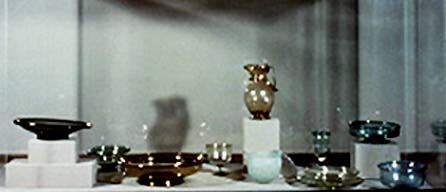
Colorful opaque inlays for opus sectile mosaic were created from pre-formed shapes fitted together. Glass also came to be used in place of marble for tessera mosaics laid on floors, walls, and vaulted ceilings. The advantage of glass tesserae over marble one rested primarily with their consistently glittery quality and their range of colors, which could be produced on demand. According to Pliny, glass mosaic for walls and ceilings was introduced at Rome in the late first century B.C.
The myriad uses made of opaque and colorful glass notwithstanding, clear glass was the most frequently admired in the world of Rome. In Pliny's words:
. . . there is no other material nowadays that is more pliable or more adaptable, even to painting. However, the most highly valued glass is colorless and transparent. . . .Surely the single most remarkable quality of glass is its ability to contain objects and liquids and yet also to admit light and permit a view from within or without. Exploiting this property, glass was put to many special uses in Roman times -- ranging, as we might expect, from the ridiculoius to the sublime. Glazed windows became quite common during the first century A.D. Fragments of such glass found at Karanis demonstrate that this early window glazing was rather thick by our standards. Although it let light in and kept wind and rain out, it was not transparent -- only translucent. Yet we can gain a sense of the healthy respect in which the ancients held their ability to create architectural enclosures that admitted light by reading Paul the Silentiary's rhapsodic description of Santa Sophia:
(Pliny, d. AD 79,Natural History XXXVI.66)
Thus rises on high the deep bosomed vault, borne above triple voids below; and through five-fold openings, pierced in its back, filled with thin plates of glass, comes the morning light scattering sparkling rays.* * *
(Paul the Silentiary, sixth century AD, Ode to S. Sophia recited at the dedication of the second church in AD 563.)
The Romans made use of the quality of transparency for practical jokes as well as for truly practical purposes. The false-bottomed wine glass is a delightful example of the former. Here, the wine was poured through a hole in the base of the cup. After the wine had filled the entire space between the false bottom of the cup and the real bottom, the hole was plugged. Thus was achieved the appearance of a glass brim-full of wine. Another specialized use of glass at the banquet table is deplored by Seneca:
A mullet does not seem fresh enough unless it dies in the hands of the banqueter; they are passed around enclosed in glass jars, and their color is watched while they expire.To be sure, the transparency of glass opened up whole new worlds of observation. Most commonly it was a case of being on the outside looking in--as to observe the demise of the mullet. In one instance, however, we find glass being perceived as a useful medium in a situation where the person is on the inside looking out at the fish. The story of Alexander's exploration of the depths of the sea in a glass submarine, is of course, fabulous. Yet it has its roots in the fact that during the period when the legends of Alexander were developing, glass was coming into its own as a material of virtually unlimited versatility.
(Seneca, d. AD 65, Naturales Quaestiones III.17.)
Practical and fanciful vessels of clear glass are illustrated by a spouted "feeder" bottle and two fragmentary bird-shaped perfume bottles. We take for granted the fact that it is a fine thing to be able to see how much a child or an invalid is drinking, but how marvelous this ability must have seemed in the early years of glass-blowing!
* * *

Dinnerware was sometimes made of glass. It was especially good for summer banqueting, according to Propertius.

And drinking cups of glass came in every conceivable shape and size.
At Karanis, conical glass vessels were used both as drinking cups and, apparently, as oil lamps to be held in fixtures for suspension. In his study of the conical vessels from the site, D.B. Harden noted that many were coated on the interior with an oily residue. He concluded that they must have been the precursors of the conical glass oil lamps which are well known from actual examples suspended from metal polycandelon fixtures in mosques of the Islamic world. Chandeliers of this type are suggested in descriptions by several Roman authors. The hanging lamps to be seen in Hagia Sophia today must be very close to the sixth-century originals extolled by Paul the Silentiary:
And beneath each chain he has caused to be fitted silver discs, hanging circle-wise in the air, round the space in the center of the church. Thus these discs, pendant from their lofty courses, form a coronet above the heads of men. They have been pierced too by the weapon of the skillful workman, in order that they may receive shafts of fire-wrought glass and hold light on high for men at night.
(Paul the Silentiary, sixth century AD, Ode to S. Sophia recited at the dedication of the second church in AD 563.)